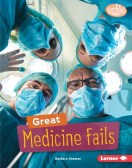
This month’s book list highlights of my most favorite aspect of science –Serendipity! Why is it my favorite? Because while everyone may say science is exact, it is anything but that. Scientists conduct do research, make hypotheses, and then conduct experiments. Many times, the results they get are not what they anticipated in the first place. But that doesn’t mean they are wrong. Perhaps they have just discovered a new element, product, or created a brand new drug that will change the world (Alexander Fleming and penicillin)… accidentally!
While you most likely aren’t crazy about the idea of letting your students just do experiments without guidelines in your classroom on the off chance they will discover something amazing, one of the best ways to introduce them to this topic is to introduce them to Mistakes That Worked: 40 Familiar Inventions & How They Came to Be by Charlotte Foltz Jones, illustrated by John O’Brien or Accidental Inventions: The Chance Discoveries That Changed Our Lives by Birgit Krols
Classroom Activities: Split the class up into four to six small groups. Have each group pick one or two inventions and discuss them amongst themselves. Write out what they think is the turning point in the discovery? Ie. When did the scientist realize what they did was not a failure but a success? And then how did they turn their product into something that was marketable? Each group can make a poster or give a talk about their invention and inventors to the rest of the class. Class discussion can focus on HOW it was turned into an invention that became a product to be sold or used. (Hint: this also teaches a bit of economics.)
Here are a few resources for students to use:
https://www.upcounsel.com/blog/how-to-turn-your-invention-ideas-into-products
https://www.entrepreneur.com/slideshow/299456
https://www.businessnewsdaily.com/8773-turn-your-idea-into-a-product.html

Have Students that want to invent something to change the world? Have them read through How To Become An Accidental Genius by Frieda Wishinsky, Elizabeth MacLeod, illustrated by Jenn Playford. This is a fabulous book for teaching kids HOW to become an inventor.
Classroom Activity:
This can be done in groups, pairs, or individually. Have students come up with their own invention. Use the steps in this book to develop a plan which contains the following
- Have them outline what their invention is
- How it will be used
- List the materials they’ll need to create it
- Design and draw it
- Develop a method for the experiment and creation
- Discuss what they’ll do if they have to make changes
- How will they market it
Then have them present it to the class. My guess is, you’ll have some pretty amazing inventions! Kids are very creative and ingenious. This could be a fun thing to share with other classes or for a STEM night at school.
Resources:
Show them this video to be inspired by REAL kids who came up with their own inventions!
https://www.youtube.com/watch?v=XiuU1mlFeEc
iKids — The Inventive Kids site is a place where children and adults can learn about inventors and inventions, and their own creative potential! https://inventivekids.com/
The OTHER part of Serendipity Science is when someone stumbles on a great scientific or technological find. Science is a made up of curiosity, perseverance, and yes, luck. Sometimes the best discovery happens when you are in the right place at the right time.
One of my favorite books that showcases how anyone can make discoveries is Sarah Albee’s Accidental Archeologist. This book is chock full of discoveries made, well, accidentally.
Classroom activity: Have the kids read through the table of contents, just to get an idea of what was discovered. They can then pick a chapter and read through as a group or individuals. Make a list of the following
- How the discovery was made
- Where the person was when it happened
- What was the person doing?
- Where they looking for something else and made this discovery instead?
Then have the students think about something they might have discovered accidentally? Have they ever found a penny on the sidewalk? Discovered a fossil? Picked up a rock that didn’t belong with the other ones? Seen an animal that is normally nocturnal (out at night) during the day? All of these are accidental discoveries. By paying attention to the world around them, maybe one day they could make a BIG discovery like the people in Albee’s book.
Resources: https://www.history.com/news/7-historical-treasures-discovered-by-accident
https://www.youtube.com/watch?v=aohkBc9GuLw
Hope you have fun with this month’s topic!
******************************************************************************

Jennifer Swanson is the award-winning author of over 45 books for kids, mostly about STEM and STEAM. She is the founder of the STEM Tuesday blog and STEAM Team Books. She has a cool podcast for kids and families called Solve IT! for Kids— check it out! You can discover more about Jennifer and book her for events at her website: www.JenniferSwansonbooks.com





















 Your host is
Your host is